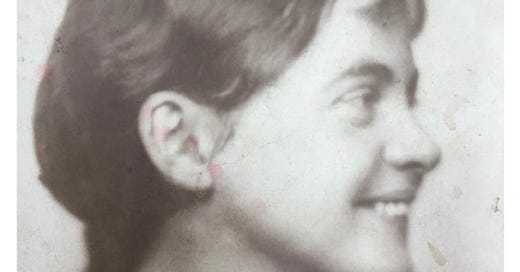In 1928, a twenty-year-old student called Elsie Phare (later known as E.E. Duncan-Jones) wrote to Virginia Woolf, inviting her to give a talk on the subject of women and fiction to the Arts Society at Newnham College, Cambridge. The society’s president Elsie Phare was in her second year studying English Literature, so it must have been thrilling when one of the great modernist writers of the time provisionally accepted the invitation (the following year T.S. Eliot politely turned her down). The success of Virginia Woolf’s To the Lighthouse (1927) had made her busier than ever, so there was some difficulty in trying to find a suitable date, but Elsie Phare was determined and did not give up easily. Eventually ‘Mrs Woolf’ sent ‘Miss Phare’ a polite letter, type-written in purple ink, accepting the date of 20th October 1928. The talk that Virginia Woolf gave that day, together with the one she gave soon afterwards at the other women’s college, Girton, would result in her book A Room of One’s Own, published in 1929, with her famous declaration of female intellectual freedom in the face of male gate-keeping at universities and elsewhere: ‘Lock up your libraries if you like; but there is no gate, no lock, no bolt that you can set upon the freedom of my mind.’1
The village girl
Elsie Phare’s confidence in inviting Woolf to Newnham was characteristic of the determination she demonstrated throughout her life. She was born in 1908 and grew up in Chelston, a village on the outskirts of Torquay in Devon, in a working-class, Wesleyan Methodist home. Neither of her parents had received an education beyond elementary level, but they both wanted to give their daughters the chances they never had. Elsie was lucky enough to attend Torquay Secondary School, where the headmistress was Mary Jackson, the niece of Henry Jackson, a classicist at Trinity College, Cambridge. Miss Jackson spotted Elsie’s drive and intellectual ability early on, and encouraged her to take the entrance examinations for both Oxford and Cambridge. Elsie passed easily and applied to Newnham College (where Miss Jackson had once been a student) and St Hugh’s, Oxford. But even the train fares from Exeter to Cambridge and Oxford were beyond her parents’ means, and - in what Elsie later described as a ‘macabre’ solution - her ticket had to be paid for from her sister’s compensation fees for injuries caused by a road accident.
Until then, Elsie had never travelled further north than Exeter, and she had mixed feelings about her first encounter with Cambridge.
‘The gardens at Newnham were delightful, the room I stayed in full of books, but there was a keen March wind and I was colder than I had ever been before’, she recalled of her interview there in 1926. ‘I had great anxieties about whether all the travelling and expenses would prove to be justifiable.’
She thought that Newnham’s Principal, Pernel Strachey, seemed ‘distant and distracted’ and Elsie was convinced that as a working-class girl she had little chance of being offered the scholarships she would need to be able to afford to study there. Her interview and stay at Oxford was a much more enjoyable experience, and Elsie wrote in her diary about how warm and welcoming St Hugh’s was. In Cambridge, on the other hand, ‘the atmosphere, physically and emotionally, was that of a refrigerator.’
However she quickly changed her mind when, much to her surprise, Newnham offered her its major scholarship in English Literature. With this, plus two other scholarships, she was able to accept a place at Cambridge in autumn 1926 despite all the odds.
Keep reading with a 7-day free trial
Subscribe to Cambridge Ladies' Dining Society to keep reading this post and get 7 days of free access to the full post archives.




